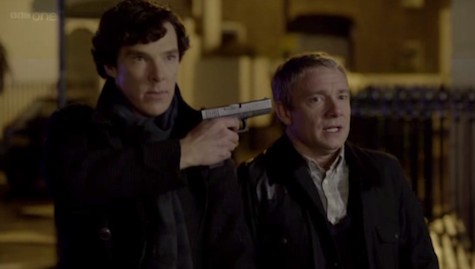The second series of BBC’s super-popular Sherlock concluded its three-part offering today, and the results were shockingly unexpected and ridiculously exciting. This feat is impressive in it of itself, but seeing as the basic plot and concept are taken from the famous (or infamous) Conan Doyle-penned story “The Final Problem,” doubly so. It’s all been leading to this, so what happens when the 21st century versions of Sherlock and Jim Moriarty try to sort out their final problem? The answer is chock full of spoilers and twists, in what was one of the most fun and engaging Sherlocks yet.
Spoilers throughout. Really.
The episode opens much like the first episode of Series 1, “A Study in Pink,” with John Watson talking to his therapist. She wants to know why it’s been so long since John has come in for an appointment. Incredulous, John says, “You do read the papers, you know why I’m here.” And then he reveals what someone who reads the papers should know; Sherlock Holmes is dead.
After the title sequence, we’re told it’s three months earlier and Sherlock Holmes is a bigger media sensation than ever. After recovering a stolen painting called “The Falls of Reichenbach,” the papers have taken to calling Sherlock “the hero of Reichenbach.” This results in an amusing sequence in which Sherlock is given gift after gift from various thankful parties, only to have each one be unsuitable to his tastes. This culminates perfectly with Lestrade and the rest of the Scotland Yard force giving him a deerstalker cap as thanks for helping with another case. Much to his chagrin, and at the urging of John, Sherlock dons the cap for the cameras.
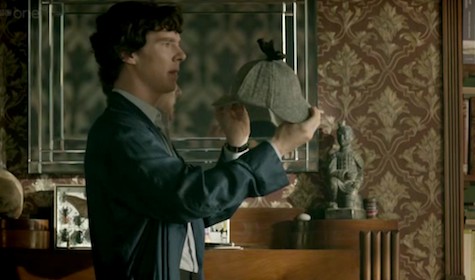
Later, back at Baker Street, John muses that the cap is no longer a “deerstalker” but rather a “Sherlock Holmes hat.” This serves nicely as a reference to the zeitgeist in real life about the famous Victorian detective, but also as an in-universe warning that the media surrounding Sherlock might be getting too big. Sherlock wonders aloud why John is concerned about this, and John worries the that “the press will turn, they always do ” Meanwhile, Jim Moriarty is free and walking the streets of London, specifically, the Tower of London. After donning headphones, Moriarty makes a few swipes on his smart phone. Simultaneously, with just the flick of a finger on an “app,” Moriarty is able to open the largest vault in the Bank of England, all the cell doors in the country’s largest prison, and walk in and steal the crown jewels. Before smashing the glass which houses them, Moriarty writes (in a fashion keeping with the Riddler) “Get Sherlock.” Shockingly, Moriarty is immediately caught and arrested.
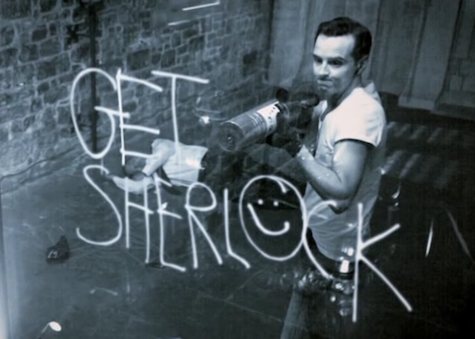
At Moriarty’s s trail, Sherlock is brought in as an expert witness to help convict the master criminal. Moriarty is bizarrely offering no defense, despite having pleaded not-guilty. Sherlock mouths off and makes numerous observations about the jury and the court officials, which eventually gets him found in contempt of court. Prior to this, Sherlock has an altercation in the bathroom with a gossip reporter posing as a fan. He tells her off with the words “You repel me.”
Next, though the judge encourages a verdict of guilty, the jury inexplicably votes for Moriarty’s acquittal and he walks free. Though it makes little sense, it seems Sherlock was almost expecting this outcome. Moriarty soon comes round to Baker Street where he taunts Sherlock with his power. Manipulating the jury was easy for Moriarty: he had threatened all the families of each juror privately, forcing them into a verdict. The trial was nothing more than an elaborate advertisement for Moriarty, a way to show various criminal parties how powerful he really is. He tells Sherlock that they are living in a “fairy tale” and every fairy tale needs its villain.
Soon Sherlock and John are called in by Lestrade to assist with a kidnapping case. Previously, a package had been delivered to Baker Street filled with breadcrumbs, indicating Hansel and Gretel. At the scene of the kidnapping, Sherlock manages to obtain samples of boot prints, which he believes will help them locate the place where the kidnappers have taken the children. By putting various chemical elements together in the lab (with the assistance of Molly), he determines the kidnapped brother and sister are being held at an abandoned candy factory: an obvious reference to Morirarty’s bizarre fairy tale fetish.
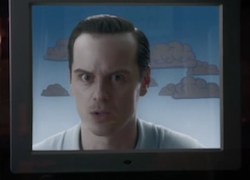
The children are indeed there, and eating candy laced with mercury. However, when Sherlock goes to question the young girl, she screams at the sight of him. This precipitates a sequence of events where the other police officers working with Lestrade, specifically Anderson and Donovan, start to suggest that Sherlock himself may have been involved with the kidnapping. As Sherlock starts to suspect this plot to discredit him, he takes a cab, and inside is subjected to a deranged video from Moriarty outlining how he intends to make Sherlock look like a fraud and how everyone will turn on him.
Soon, Lestrade arrives at Baker Street and arrests Sherlock. Watson initially is not under arrest, but after punching Lestrade’s superior, the pair are handcuffed together. At this point, instead of going quietly, Sherlock and John make a break for it, complete with gun-wielding antics. They head for the flat of the gossip reporter Sherlock met before the trial, who has recently run an “exclusive” about Sherlock’s past for a local rag. Upon breaking into her apartment they discover she is harboring Moriarty, who claims to be a man by the name of Richard Brook. The journalist explains to John that Moriarty is a fictional creation, one of Holmes’s design. Richard Brook was the actor hired by Holmes to pretend to be his arch-nemesis. The evidence Moriarty has created to perpetrate this deception is deep, including Richard Brook’s job for a children’s program, one in which he tells fairy tales.
After leaving in disgrace and confusion, Sherlock oddly goes to see Molly and asks her for a favor that is never disclosed before his final confrontation with Moriarty. (In a previous scene, Molly was the only one who noticed that Sherlock was visibly worried, but acting strong around John.)
Throughout the episode Moriarty has lead Sherlock (and Mycroft and the government) to believe that he has a secret computer code, which allows him to open any door. However, upon meeting on the rooftop of St. Bart’s Hospital, Moriarty reveals there was never any secret code; he simply had a network of lackeys that he paid off. Moriarty’s trap and effort to destroy Sherlock is almost complete: the media has discredited the great detective as being a fraud, someone who hired actors and engineered the crimes he “solved.”
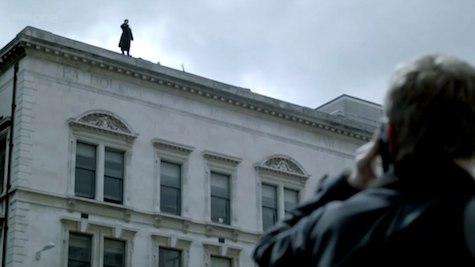 Now Moriarty is demanding Sherlock Holmes to commit suicide in disgrace. If he doesn’t, Moriarty has snipers ready to kill Lestrade, Mrs. Hudson and John. Sherlock realizes that he is safe from this fate as long as Moriarty is alive to call it off, but then, in a gruesome act, Moriarty shoots himself in the head. Sherlock calls Watson and tells him “the truth.” He claims he was a fraud, and that he is giving Watson his “note.” Sherlock then jumps and presumably falls to his death. Notably, just after Sherlock’s body hits the pavement, John is knocked over by a bicycle messenger, disorienting him at the scene of the tragedy.
Now Moriarty is demanding Sherlock Holmes to commit suicide in disgrace. If he doesn’t, Moriarty has snipers ready to kill Lestrade, Mrs. Hudson and John. Sherlock realizes that he is safe from this fate as long as Moriarty is alive to call it off, but then, in a gruesome act, Moriarty shoots himself in the head. Sherlock calls Watson and tells him “the truth.” He claims he was a fraud, and that he is giving Watson his “note.” Sherlock then jumps and presumably falls to his death. Notably, just after Sherlock’s body hits the pavement, John is knocked over by a bicycle messenger, disorienting him at the scene of the tragedy.
Time passes and we see John and Mrs. Hudson at Sherlock’s grave, where John gives perhaps the most heartfelt speech of the entire series and asks for one more miracle; the miracle that Sherlock is not dead. As Watson walks away from the graveyard in tears, the camera pans over to a figure standing in the shadows. Sherlock Holmes is alive!
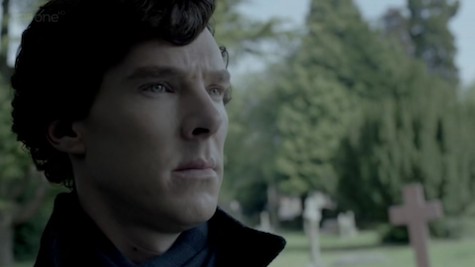
Ryan’s Reaction:
Wow. This episode was not what I expected from a Holmes/Moriarty confrontation, and I couldn’t have been happier at my surprise. Whenever writers tackle and adaptation of “The Final Problem,” I believe they’re almost always poised to make it at least a bit more coherent than the original Conan Doyle story. The recent Guy Ritchie movie certainly accomplished this, by giving us perhaps the best justification for the Victorian Holmes to plunge into the abyss of the roaring Reichenbach falls. Here, in the contempary version of these adventures, the motivations of Moriarty aren’t as clear cut and aimed towards world domination. Instead, Moriarty wants to see Holmes completely broken and destroyed, even at the cost of his own life. This Moriarty is sadistic and cruel on levels unparrelled with other versions of the famous villain. The concept of driving Holmes to accept a lie of being a fraud, and also drive him to willing suicide are exceedling dark, and handled perfectly. The dialogue in almost every scene is spot-on, with special attention to the first scene in which Molly confronts Holmes about what’s really going on. It’s moving, and unexpected and acted wonderfully.
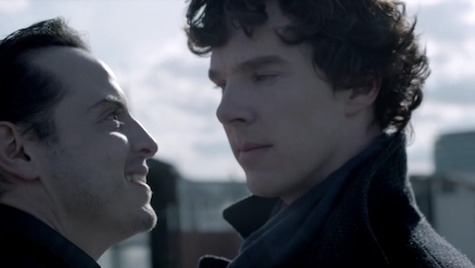
And then, the final scene with Sherlock and Moriarity in which Holmes says “You want me to shake hands with you in hell, I shall not disappoint you,” ought to rank up there with some of the best delivered dialogue of all time. The writing and the acting are top-notch in this one and I have to say, I didn’t see this plot concept coming at all.
The idea that Moriarty is out to discredit Holmes is totally brilliant, and the idea of Holmes “inventing” Moriarty exists in all sorts of pastiches, though most-famously in Nicholas Meyer’s novel The Seven Per-Cent Solution. Perhaps the other reason this notion works so well is because it addresses the meta-fictional conceit that Doyle invented Moriarty for the occasion of doing away with Holmes. Moriarty literally serves no function other than that, and is not character in the true sense of the word, at least not on the page in the original text. Now that Moriarty IS a fully-realized character, the writing of “The Fall of Reichenbach” acknowledges this quirk of the story, and layers on the meta-fiction with fairy tale stuff. Having Moriarty’s false identity even be a kindly-storyteller of children’s tales makes it even better and creepier.
I knew after I saw Sherlock’s bloodied body that he was not truly dead, but the final reveal of him standing alive was so satisfying. We know he must have had Molly do some medical mumbo-jumbo to him prior to his jump from the top of the building. Why else would he go to her? She was the only one of his “friends” who Moriarty did not mention. The idea that Sherlock alienates many people around him was played with in this episode as it served to fuel the media frenzy that he was actually a fraud. But on the personal level, it was nice to see that even those who he might mistreat, still care about him and will go great lengths to save him.
This was stunning end to a great second wave of what is probably the best version of Sherlock Holmes we’ve seen since the Jeremy Brett days.
Emily’s Reaction:
Okay, I have a thing for equal opposites, those stunning hero-villain duos. It’s like watching a perfect chemical reaction in lab class. So I’ve sort of been in love with this Holmes-Moriarty pairing from the get-go, and understandably concerned about their final outing. It had to do them justice, the both of them. Moriarty couldn’t be that phantom cardboard cutout that Doyle unfortunately created for “The Final Problem.” Holmes couldn’t go out with nothing more than an unseen brawl on a slippery outcropping. Give me the battle, the real battle, and make it frightening. I wanted to be dreading every second.
I was not disappointed.
To begin with, what they extracted from the material was honestly more impressive than any of the previous episodes. The whole idea of disgracing Sherlock, of making it about a descent in the eyes of the world, is basically taken from a simple piece of narration at the start of Doyle’s story: Watson explains that the reason he feels the need to put the tale to paper is because Moriarty’s brother wrote his own piece, lying about what truly happened, and Watson needs to set this to rights. It’s an honorable reason to be sure, but Watson wasn’t publishing this piece on the internet, where everyone can instantly tear it apart. So rather than write a rebuttal within the show, John Watson’s blog (if you don’t follow it during the series, I highly recommend it) merely contains a final insistence that Sherlock was his friend and wasn’t a fraud. And then he closes his blog for comments. Because this Watson doesn’t quite have the way with words that his canon counterpart did, and he simply can’t handle the backlash that this whole debacle has created.
What we get instead is his fretting throughout the episode, the fear in his eyes when he tells Sherlock that he doesn’t want anyone to think he’s a fake. Because this matters to John, but he’s not really a writer who can use words to spin Sherlock into the hero he sees. He’s just a guy with a cool blog who doesn’t have the power to defend his best friend. The fact that they pulled an entire emotional arc from one piece of setup at the start of “The Final Problem” is just gorgeous.
There’s also a way in which they flipped the story on its head completely: throughout “The Final Problem,” Holmes continually tells Watson that so long as Moriarty is brought to justice, he can count his career completed. This is ostensibly because he is aware that he might die, and could be trying to hint at Watson that he’s fine with his life ending here. (It’s also Doyle trying to tell the reader this, as he did intend it to be the final Holmes story when he initially wrote it.) But this Sherlock is too young, too manic, too intent on the next best thing to be done now. He hasn’t been a career consulting detective successfully for long enough to be satisfied.
Instead, we have Jim. Jim who, it could be argued, set this whole thing up to answer a simple question: are you my equal? Really and truly? He tests Sherlock at every turn to find out, and by the end he’s disappointed. He thinks that Sherlock doesn’t get it, can’t get one over on him, that’s he’s just as boring as everyone else. After all, he fell for the “couple lines of computer code that can control the world” trick. (I have to admit, I rolled my eyes when they first mentioned that as Moriarty’s big secret. It was, as they like to say, “boring.” When it turned out that Sherlock was wrong to buy it, I was completely delighted.) But finally Sherlock reveals himself to be everything that Jim hoped he was. They are the same. He found his match, the only one in the whole world; you can imagine how long he had been searching for that. And it turns out that Jim Moriarty is the one who is fine with his life ending, so long as he has that knowledge.
Provided that the world can’t have Sherlock either, now that he’s done.
But, just like their little game always illustrates, what he really should have asked again before turning a loaded gun on himself was, “What did I miss?” It was simple, of course. He had snipers trained on John, Mrs. Hudson, and Lestrade. He had all of Sherlock’s friends. Except the one who didn’t count.
Molly Hooper. She is undoubtedly my favorite addition that this show has made to the Holmesian universe. Earlier in the episode we were given a moment, that perfect moment where Sherlock was forced to admit that Molly was his friend too, for all that he couldn’t stand her awkwardness and bad attempts at flirting. And now that she was honest with him, he was finally able to be honest in return. But Jim didn’t know that. Moriarty missed one of Sherlock’s friends because he, like Sherlock previously, had overlooked her importance entirely. And we all know that’s where he made his mistake because only one person was available to help Sherlock stage a fake suicide.
The only question left now is, how the hell did he manage it? Who knows how long we’ll have to wait to find out. That’s just not fair. (And because it is TV, and only other question is, is Jim really dead? I will always be worried that he’ll suddenly reappear a few seasons later. Television can never resist resurrection.)
Ryan Britt is the staff writer for Tor.com.
Emmet Asher-Perrin is the Editorial Assistant for Tor.com. She had a disturbing nightmare after she watched this episode, where Jim Moriarty merged with some Guillermo del Toro-like villain. It was just as horrific as it sounds.










